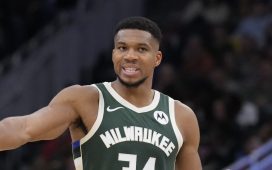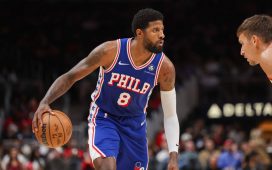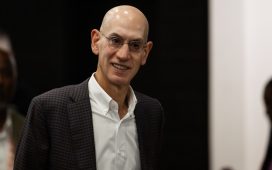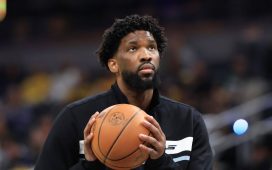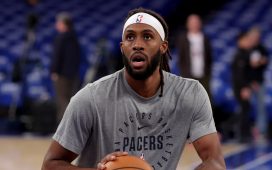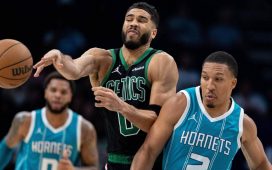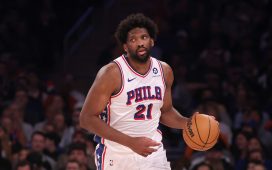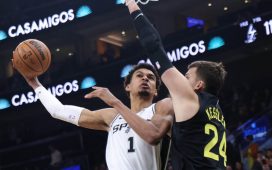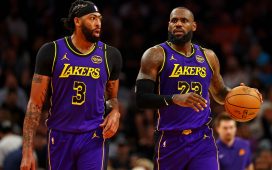The Bounce Newsletter | This is The Athletic’s daily NBA newsletter. Sign up here to receive The Bounce directly in your inbox.
Free agency starts Sunday. That means you have 48 hours to binge all 10 episodes of “The Bear.”
Family Business
Lakers draft Bronny … and it’s a hoops move
I have a controversial idea for the internet: two things can be true at the same time. (Sorry, I should have made sure you were sitting down first.) The Los Angeles Lakers drafted guard Bronny James (USC), son of NBA all-time leading scorer LeBron James, with the 55th pick of the 2024 draft. Yes, nepotism definitely helped land Bronny on his dad’s team, considering his dad is arguably the most powerful and influential player in league team-building history. Jovan Buha has more on why the moment is so historic for the father-son duo and the Lakers.
Also? It might end up being a pretty savvy basketball move for the Lakers. When guard Dalton Knecht (Tennessee) fell out of the top 10 and went to the Lakers at 17, it was viewed as a windfall for the franchise. He’s a good scorer and a good shooter, something the offensively challenged Lakers could use. Getting him in the latter half of the first round is good value.
What does that have to do with Bronny? His projections and place relative to his high school class and fellow draft prospects have been all over the place and should be taken with massive grains of salt because of clickbait fear. Following his senior season of high school, he was consistently ranked in the top 30 college recruits. ESPN had him 19th in his class. Rivals and 247Sports had him 26th. Those rankings don’t mean everything, but they’re a decent enough measurement of expectation.
Behind the call for pick No. 55 📞 pic.twitter.com/Dcn1nnwLlU
— Los Angeles Lakers (@Lakers) June 28, 2024
Then, on July 24 of last year, Bronny, at 18 years old, collapsed on a practice court due to cardiac arrest. It was an undeniably scary, life-altering moment in so many ways – unfathomable to most. Less than five months later, he played a basketball game for the USC Trojans. That almost doesn’t make sense, no matter how resilient an athlete might be. It’s safe to say Bronny was a mediocre role player in his lone season at USC. It’s also safe to say … OF COURSE HE WAS! He suffered cardiac arrest mere months prior.
Prior to that, Bronny was often projected as a first-round selection. Maybe a great season would have gotten him into the lottery, but he was taken late in the second round yesterday. Guard Isaiah Collier, his USC teammate, was also projected as a lottery pick prior to a disappointing season at USC. He fell to Utah at No. 29. There’s a chance USC was a bad program for these guys from a basketball standpoint. That team went 15-18 and just wasn’t good this year.
Sixteen-year veteran and 2023 champion Jeff Green had open heart surgery during his NBA career and missed an entire season as a 25-year-old. If Bronny is able to fully bounce back from and realign his player development path, there’s a chance he could be a very good guard in an NBA rotation.
Sure, I bet Klutch Sports tried to block anybody but the Lakers from getting him, although Phoenix was a reported possibility. That happens with many late-round prospects and potential teams. Sure, LeBron can now play NBA basketball with his son, which has been talked about long enough for many people to have grown numb to the idea – some are even annoyed. I kind of get it, but – even with my cold, cynical heart – also think it’s pretty incredible this gets to happen.
I have no idea if Bronny will be good in the NBA. I do think the Lakers made a sound move for multiple reasons in banking on him being someone who can someday help them. Drafting a potential first-round pick at 55? That’s good value, nepotism or not.
Summer League up next! 🍿
📅 July 12-22 • Las Vegas#NBA2KSummerLeague https://t.co/qDb8DT8vBT
— NBA (@NBA) June 28, 2024
The Latest From Shams
Quickley staying put in Toronto
With the NBA Draft complete, the league’s attention now turns toward free agency.
The first big post-draft move came this morning, as guard Immanuel Quickley intends to sign a five-year, $175 million deal to return to the Toronto Raptors, a league source told The Athletic.
The 25-year-old restricted free agent joined the Raptors in December as part of a deal that sent OG Anunoby to the New York Knicks. In 38 games (all starts) with the Raptors, Quickley averaged 18.6 points, 4.8 rebounds and 6.8 assists per game on 39.5 percent shooting from 3.
Keep up with all the free-agency news and rumors over the weekend right here.
Ummm sirrrr…. Remember back in school when I paid for your chick fil a. 😂😂 @IQ_GodSon https://t.co/helsNUdGrj
— Tyrese Maxey (@TyreseMaxey) June 28, 2024
Start Me Up!
How many starters could this class provide?
While we’re unlikely to find franchise-changing players in the 2024 draft class (making it even less of a big deal that the Lakers gambled a second-round pick), many of us have been selling this year’s selections as role players you can add to your rotation for a decade. This class isn’t devoid of talent; it’s just lacking star power in a year sandwiched between Victor Wembanyama and the loaded 2025 class starring Duke’s Cooper Flagg. As I watched the two-day draft, I talked to a lot of people about how many of the lottery or first-round guys would be definite starters.
Dreams turned to reality for the 2024 #NBADraft Class! 🌟 pic.twitter.com/mFxacY6gBV
— NBA (@NBA) June 28, 2024
How many unread texts after being drafted? 🤔
The 2024 #NBADraft Class sounds off on their phones sounding off! 😅 pic.twitter.com/2ZFP5IXEts
— NBA (@NBA) June 28, 2024
Many comparisons have been made back to 2013, when Anthony Bennett was picked first overall and we wondered why Nerlens Noel fell out of the top five. We should figure out how many lottery picks between 2010 and 2019 have been definite starters. (I left out 2020-2023 just to give those classes more time.) The measure? Simply whether someone with longevity started at least half of their NBA games:
- 2010: John Wall, Derrick Favors, Wesley Johnson, DeMarcus Cousins, Greg Monroe, Al-Farouq Aminu, Gordon Hayward, Paul George. 10/14.
- 2011: Kyrie Irving, Tristan Thompson, Jonas Valančiūnas, Brandon Knight, Kemba Walker, Klay Thompson, Marcus Morris. 7/14.
- 2012: Anthony Davis, Michael Kidd-Gilchrist, Bradley Beal, Dion Waiters, Damian Lillard, Harrison Barnes, Andre Drummond. 7/14.
- 2013: CJ McCollum, Kentavious Caldwell-Pope, Victor Oladipo, Steven Adams. 4/14.
- 2014: Andrew Wiggins, Joel Embiid, Aaron Gordon, Marcus Smart, Julius Randle, Elfrid Payton, Dario Šarić, Zach LaVine, T.J. Warren. 9/14.
- 2015: Karl-Anthony Towns, D’Angelo Russell, Kristaps Porziņģis, Willie Cauley-Stein, Myles Turner, Devin Booker. 6/14.
- 2016: Ben Simmons, Brandon Ingram, Jaylen Brown, Buddy Hield, Jamal Murray, Jakob Poeltl, Domantas Sabonis, Taurean Prince. 8/14.
- 2017: Lonzo Ball, Jayson Tatum, De’Aaron Fox, Lauri Markannen, Donovan Mitchell, Bam Adebayo. 6/14.
- 2018: Deandre Ayton, Luka Dončić, Jaren Jackson Jr., Trae Young, Wendell Carter, Jr., Collin Sexton, Mikal Bridges, Shai Gilgeous-Alexander, Miles Bridges, Michael Porter Jr. 10/14.
- 2019: Zion Williamson, Ja Morant, RJ Barrett, De’Andre Hunter, Darius Garland, Coby White, Rui Hachimura, P.J. Washington. 8/14.
As you can see, we get 7.5 starters on average from any given lottery. That’s even with the 2013 class bringing down the average with just four lotto picks.
Looking at 2024’s lottery class, the only rookie who currently looks like a definite starter right away might be just forward Alex Sarr in Washington. Everybody else has definite veterans ahead of them for now and the near future. Forward Zaccharie Risacher could be there in Atlanta. Everybody else? We’ll have to wait and see.
Free-Agency Primer
The big wrench in free agency
Yesterday, I shared a free-agency primer to prep for Sunday, when teams and players can officially reach verbal agreements on new deals to join a different squad as of 6 p.m. ET.
A fresh wrinkle: The new collective bargaining agreement is in full effect, so teams now have to navigate the dreaded first and second luxury tax aprons. What does that mean? Here are some restrictions for the teams in the second apron of the luxury tax:
- Not allowed to acquire players in a sign-and-trade, use existing trade exceptions or take back more money in a trade.
- Not allowed to send out your own free agent in a sign-and-trade deal for them if you’re still over the second apron with the trade package coming back.
- Can’t use a trade exception created from a sign-and-trade.
- Can’t send out multiple players to match the contract of an incoming player in a deal.
The owners and players union made things tougher for teams spending ample money to compete. Why? Owners love to overreact when things don’t go their team’s way. Also, second-apron teams might not be able to trade their 2031 first-round pick, and could even see it pushed to the end of the first round that year. That’s one of many penalties for keeping a good team together.
At least six teams project to be in the second apron. Seven are expected to reach the less-harsh first-apron status. As you wonder if your team can make a big trade, you have to know some legalese, just as the basketball gods intended! Happy spending, everybody! Make sure you’re following Shams on all socials.
Bounce Passes
John Hollinger can explain why France is invading the NBA now.
Was the new two-day draft format a success? Fred Katz can tell you.
Here is full analysis of all 58 picks of the 2024 NBA Draft.
Sign up for our other newsletters:
The Pulse 🌎 | The Athletic FC ️⚽ | The Windup ⚾| Full Time ⚽| Prime Tire 🛞| Scoop City 🏈| Until Saturday 🏈
(Photo: Jeff Haynes / Getty Images)
